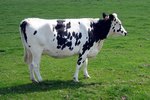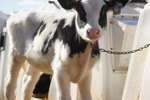
Mad cow disease, officially known as bovine spongiform encephalopathy, is a deadly disease that kills cattle by destroying the tissues of the nervous system. Mad cow disease has posed a significant problem for cattle owners in the United Kingdom. A small number of cases have also occurred in North America. It is important for cattle owners to recognize the signs and symptoms of mad cow disease to prevent the illness from spreading.
Understanding Mad Cow Disease
Mad cow disease occurs when prions -- a disease-causing form of a normal protein -- around the brain and the spinal cord begin attacking the healthy tissue, causing the cow's condition to decline. Mad cow disease is not contagious in the traditional sense, meaning that a cow can not catch it from being in the company of an infected animal. Mad cow disease spreads when humans or animals consume the tissue of an infected cow. Mad cow disease can still spread even after infected tissue has been cooked. Most cows get mad cow disease from eating feed that contains contaminated tissue. Humans that consume infected tissue can develop a brain condition called Creutzfeldt-Jakob disease. A cow can have mad cow disease for 4 to 5 years before she begins to show symptoms.
Behavioral Symptoms
Cattle who are infected with mad cow disease will often begin to show behavioral changes before the condition becomes full blown. So-called "mad cows" may behave in a nervous, aggressive or irritable manner that is unusual for cattle to display. Cows who are normally easy to handle may become difficult to work with or begin to display strange reactions in response to everyday events.
Physical Symptoms
A cow who is in the early to moderate stages of mad cow may show a change in normal posture, begin to have coordination problems and behave as if she is dizzy. If the cow is lying down, she may struggle to stand back up. Affected cows also suffer from a decrease in milk production and may lose weight regardless of how well they are fed.
Full Blown Mad Cow Disease
In addition to the earlier symptoms, a cow who is the final stages of the disease may moan or groan, twitch for no visible reason, be unable to stand up, be unable to walk and will ultimately die. If you believe your cow is suffering from mad cow disease, call your veterinarian immediately to have her tested. You should not eat or sell any meat taken from a cow who you believe may have died from mad cow disease.
References
Photo Credits
-
Digital Vision./Photodisc/Getty Images
Writer Bio
Jen Davis has been writing since 2004. She has served as a newspaper reporter and her freelance articles have appeared in magazines such as "Horses Incorporated," "The Paisley Pony" and "Alabama Living." Davis earned her Bachelor of Arts in communication with a concentration in journalism from Berry College in Rome, Ga.



